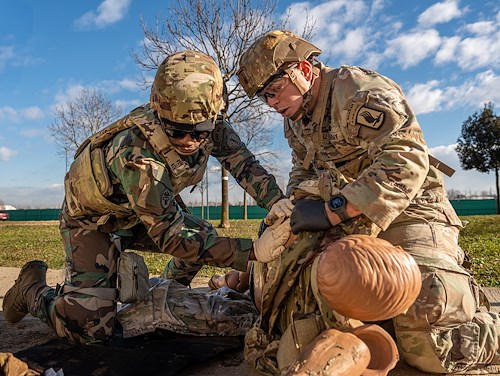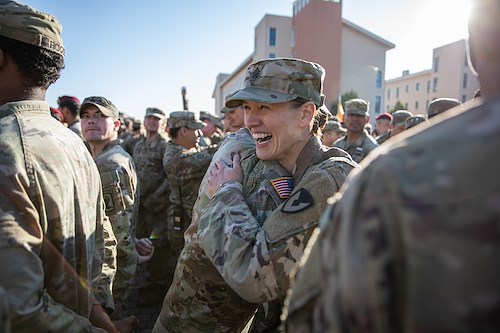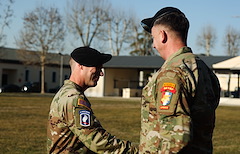Gallery contains 4 images
×
Photo 1 of 4
Humanitarian assistance starts with the HART
Joyce “JB” Blanchard, a Center for Excellence, Disaster Management and Humanitarian Assistance instructor, reviews information sharing techniques during Humanitarian Assistance Response Training at the Hall of Heroes on Caserma Ederle in Vicenza, Italy, July 2, 2019. The HART course prepares United States military commanders and their staffs to respond more effectively during civilian-led humanitarian assistance and foreign disaster response missions.
Photo by: Sgt. Sharifa Newton
Photo 2 of 4
Humanitarian assistance starts with the HART
Dr. Joyce “JB” Blanchard, Center for Excellence, Disaster Management & Humanitarian Assistance instructor and Javier Fernandez-Nazario, a Personnel Recovery and Plans Specialist, U.S. Army Africa, discuss planning considerations during Humanitarian Assistance Response Training at The Hall of Heroes on Caserma Ederle, Vicenza, Italy, July 2, 2019. This operational-level course focuses on applying the military planning and decision-making process to the unique circumstances associated with a foreign humanitarian assistance operations.
Photo by: Sgt. Sharifa Newton
Photo 3 of 4
Humanitarian assistance starts with the HART
Jamie LeSueur, an International Federation of Red Cross and Red Crescent Societies representative, goes over international humanitarian law during Humanitarian Assistance Response Training at the Hall of Heroes on Caserma Ederle in Vicenza, Italy, July 2, 2019. This operational-level course focuses on applying the military planning and decision-making process to the unique circumstances associated with foreign humanitarian assistance operations.
Photo by: Sgt. Sharifa Newton
Photo 4 of 4
Humanitarian assistance starts with the HART
Jamie LeSueur, an International Federation of Red Cross and Red Crescent Societies representative, discusses operational pillars of response during Humanitarian Assistance Response Training at the Hall of Heroes on Caserma Ederle in Vicenza, Italy, July 2, 2019. The HART course prepares United States military commanders and their staffs to respond more effectively during civilian-led humanitarian assistance and foreign disaster response missions
Photo by: Sgt. Sharifa Newton
VICENZA, Italy -- When disaster strikes, agencies and militaries from across the world spring into action to mitigate damage and death and to provide assistance to those in need. But how do they know who to help and what their limitations are? Where does the planning begin? At the HART, of course.
Humanitarian Assistance Response Training is an operational-level course focusing on applying the military planning and decision-making process to the unique circumstances associated with a foreign humanitarian assistance operation. A HART training took place at the Hall of Heroes on Caserma Ederle in Vicenza, Italy, July 2-3.
“What we're trying to do here is give people that awareness of not just their mission, but also the bigger stakeholders that are out there that they're going to be working with, like those nongovernmental organizations, humanitarian stakeholders, other government agencies and the agencies that will support in their sphere,” said Jenny Caruso, an instructor from the Center for Excellence, Disaster Management and Humanitarian Assistance.
During the training, the participants went over realistic scenarios, case studies, small group practical applications and role-playing exercises enhanced by lectures from civilian and military experts.
The students and experts were also allotted time to converse and discuss operational boundaries and techniques.
“You don’t want to be exchanging business cards in the middle of a disaster,” Caruso said. “This course gives everyone involved the opportunity to connect and network with the folks they’ll reach out to when a disaster happens.”
In addition, the participants learned detailed information on how the U.S. military supports humanitarian assistance and disaster relief.
“A course such as this one allows you to get to know those points of contact, what the priority is to them, and how you can best augment them when you may or may not be needed,” said Maj. Chad Thibodeau, the U.S. Army Africa Civil-Military Operations Center current operations chief. “It also gives you great resource websites.”
Overall, HART prepares U.S. military commanders and their staffs to respond more effectively during civilian-led humanitarian assistance and foreign disaster response missions.
“I think this training is exceptionally valuable,” Thibodeau said. “Whether it's the first time or the fifth time that you've received this training, you always pull different pieces out that are important.”
In the future, HART instructors hope to pass on their knowledge more frequently.
“We’d like these classes to take place more often,” Caruso said. “This is only the second time we've done a class for USARAF, as well as AFRICOM, but we're setting up that relationship and we hope to be doing this on an annual basis.”
















